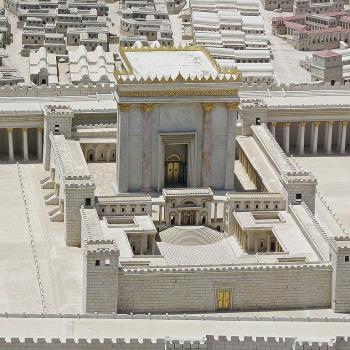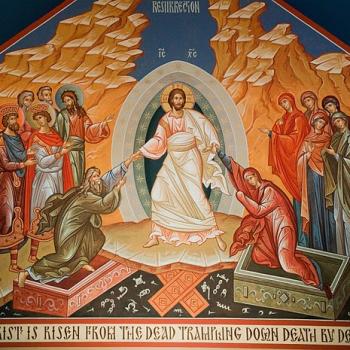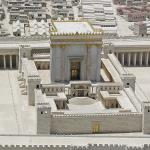![Christ the True Vine by Anonymous. [Public domain], via Wikimedia Commons](https://wp-media.patheos.com/blogs/sites/637/2017/02/Christ_the_True_Vine_icon_Athens_16th_century-221x300.jpg)
In his transformative human activity, in his work in and through history, the Logos is able to be ascertained and experienced in a variety of ways. For example, some will be derivative in form, secondary representations based upon his actions in history. Others will include how he unites himself with others, so that his humanity is itself one with the rest of humanity and not separate from it. And finally, some others will include an experience of the Logos in accordance to his glorified or divine forms working in and through his historical manifestation. Those who are able to see him in such transfigured glory the ability to better understand and appreciate the unity of his person and to see that all such forms are not to be divided from each other but to be seen as relative distinctions of the one and same Logos.
According to many different factors, including the time and place of the encounter, and the condition of the person or peoples doing the encountering, The Logos will be experienced in one of many possible forms. Each form truly is of him, but some reveal more of him than others, while others, like a cloudy mirror full of dirt, distort the image of Christ, making it difficult to see his presence even though it is there. Indeed, he can be found and experience in and through all nature as the Logos from which all the logoi flow, giving everyone a sense of the grace which is being offered by the Lord of Nature, while it is only in and through the incarnation the full realization of his person is able to be understood by us.
While much can be said about each of these forms, the identification of some of the more important examples a simple summarization of what each of those examples represents can be quite useful, because it then will open our awareness of the possibilities which lie before us in our encounter with the Logos. This should then motivate us to see and realize the work of the Logos in all the forms of the Logos we meet in our lives; some we will be able to grasp and appreciate better, some we will grasp less, some we will find will transcend us and will remain incomprehensible but yet even then, our knowledge of the Logos increases as we encounter him in his transcendent forms as they elevate us and make us that much more enlightened in the process. Moreover, once again, we must always keep in mind that even if we are more familiar with the Logos in one or a few forms, all of them represent him and are one, because the Logos is one and not to be divided. That is, while we can talk about the many forms or even bodies of the Logos, they are logical and not personal distinctions, and only when their union together is realized by us can we present who the Logos, the Christ, actually is.
Thus, we can see the presence of the Logos, the Christ, in prophecy (which includes all form of authentic prophetic revelation, especially but not limited to, Holy Scripture). Truly it can be said to form a body in which the presence of Christ is manifest. Although it can be said to be more spiritual than physical, this is not to deny Christ’s active work, through his divinity, in the establishing of prophetic words which reflect him, the Word, enabling him to prepare and shape those whose encounter with him is in this form. This is why Origen could write:
All who believe and are assured that grace and truth were obtained through Jesus Christ, and who know Christ to be the truth, agreeably to His own declaration, “I am the truth,” derive the knowledge which incites men to a good and happy life from no other source than from the very words and teaching of Christ. And by the words of Christ we do not mean those only which He spoke when He became man and tabernacled in the flesh; for before that time, Christ, the Word of God, was in Moses and the prophets. For without the Word of God, how could they have been able to prophesy of Christ? And were it not our purpose to confine the present treatise within the limits of all attainable brevity, it would not be difficult to show, in proof of this statement, out of the Holy Scriptures, how Moses or the prophets both spoke and performed all they did through being filled with the Spirit of Christ.[1]
Similarly, as the prophetic form prepares the way for us to encounter the Logos in other forms, it also worked to prepare for the incarnation of the Logos into history as the man Jesus Christ. Here is the primary form in which he is known to humanity, as a historical person who had a birth, an active life, and an end to his life on the cross. Christians know that in his historical presence as a human, he is also divine, the same person, God and man, but his activity as God is often hard to discern, for his actions there transcend his temporal form.[2]
The historical Christ represents what the Logos accomplished in empirical time and space, and how his actions affect people in the temporal sphere. It is the most humanly-centered form of Logos, and as such, is mostly known in and through the form Christ took in the incarnation, as a Jewish man who lived in the land of his ancestors, acting in and with his people as well as with those Gentiles who came in contact with him. It is the man who said and did extraordinary things, a man who was concerned with the abuses or sins he found embraced by humanity, but especially those abuses performed by those in positions of spiritual or temporal power, as well as a man who found himself in conflict with the authorities of his time because he condemned their abuses while preparing for a new form of living in the world which would undermine their very authority. Seen as a revolutionary by both the spiritual leaders of Israel as well as by Roman authorities, he was executed as a criminal, giving an end to his purely temporal form of existence.
Then the Logos comes to us a resurrected and glorified form. While it too can be seen a partly partaking of history, in his glorification, he transcends it. His actions are no longer bound by his historical-empirical, as can be seen by the way he comes and goes as he pleases, no longer bound by material laws.[3] In his glorified form, he acts in history but is now the Lord of history, capable of lifting this in history up beyond history to meet him in his transcendent form, in a form which mediates the glory of the kingdom of heaven, the joy of beatitude, to the blessed.
The glorified, resurrected body of Christ, which is real and truly his for eternity, must be seen as the form which represents the bridging between time and eternity, and so is neither purely one or the other, but a bridge which brings the eternal glory into time so that time can be lifted up into eternity. It is not normally able to be seen by those whose mind are attached purely to the physical-historical reality, but through grace, like St. Paul, even then can be awakened to a vision of the glorified Christ and be transformed. Others, who have slowly worked with the Logos, walking and wrestling with him, receiving grace through him, will see the veil which separates them from the glorified Christ ripped from the altar of their inner temple, and so will also see the glorified Christ and encounter him in their lives. The more they have emptied themselves from all negative attachments of sin, the more that veil will be lifted, and the more they will encounter Christ in his glorified form. With it, the Logos fulfills his mediation between creation and creator.
















